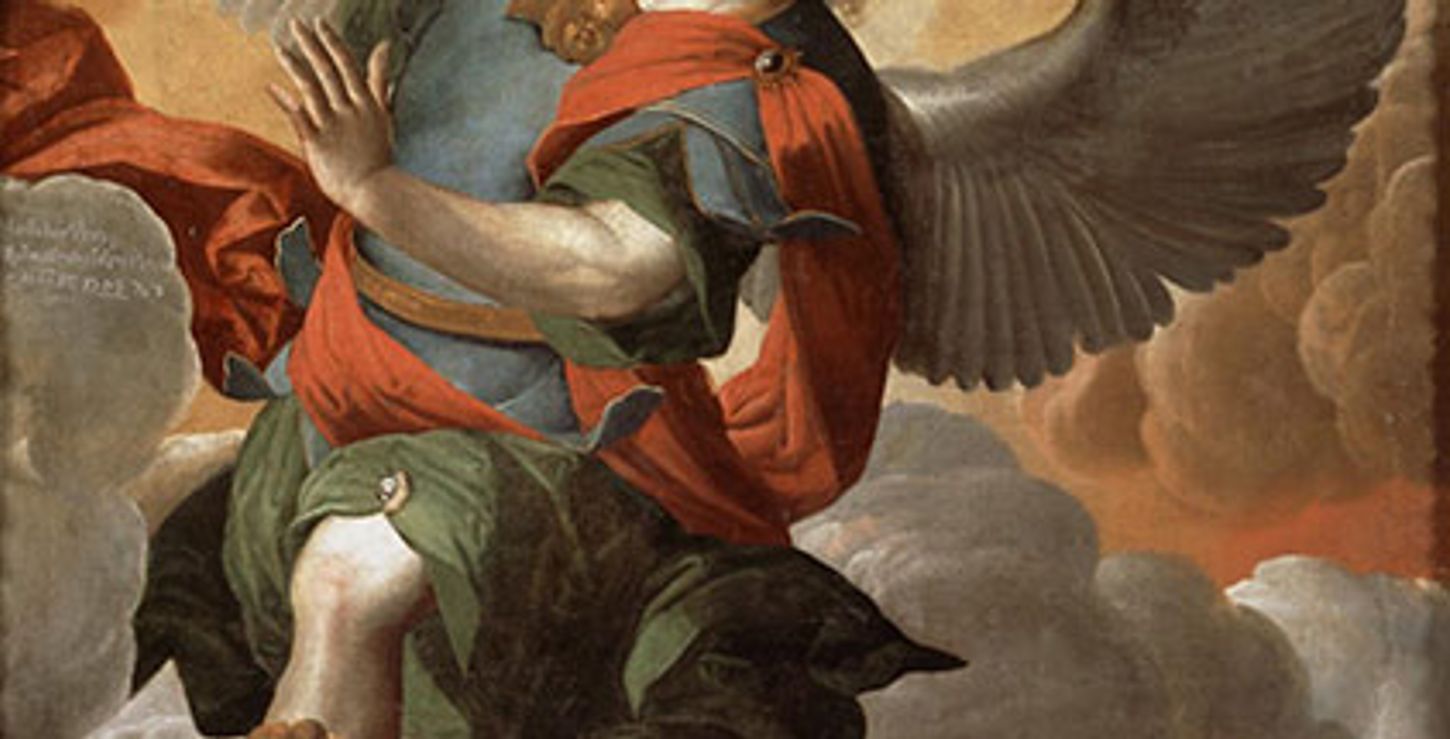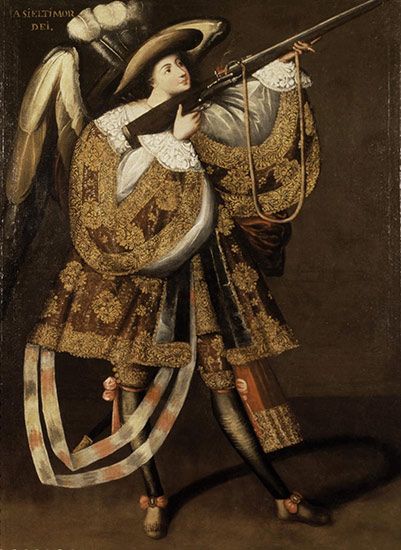Dorrance Special Exhibitions Galleries, first floor
Main Building

Saint Michael Archangel Melchor Pérez Holguín (Bolivian) 1708 Oil on canvas Museo Nacional de Arte, La Paz, Bolivia
Drawn from public and private collections throughout the Americas and in Europe, Tesoros / Treasures / Tesouros: The Arts in Latin America, 1492–1820 is a pan-national exhibition spanning the centuries from the arrival of Columbus to the emergence of national independence movements. It features some 250 works of art created in what is today the countries of Argentina, Bolivia, Brazil, Chile, Colombia, Cuba, Dominican Republic, Ecuador, Guatemala, Mexico, Peru, Venezuela, and the Commonwealth of Puerto Rico.
The complex story of cultures and art… var f_divname="mp3player"; var f_width=133; var f_height=100; var f_file="Tesoros Overview,Tesoros Natural Riches,Tesoros African Culture,Tesoros Asian Influence"; var f_filetype="exhibitionMinutes"; var f_title="Overview,Natural Riches,African Culture,Asian Influence"; Listen to or download curator Joseph Rishel's 4-part Podcast. Available in
Magnificent—and often startling—works of art in all mediums are presented in this exhibition, from spectacular examples of painting and sculpture to feather-work, shell-inlaid furniture, objects in gold and silver, ceramics, and textiles. Manuscripts and maps are also included to illustrate how the earliest contact between Europeans and indigenous populations created a crisis in identity and self-representation that eventually lead to a new culture, born of a mix of creative energies, confidently expressed in the arts. Superb examples of craftsmanship reflect the interchange between diverse cultures, and although many of the objects on view were created by indigenous, mestizo, and European artists whose names have been long forgotten, visitors may also become familiar with artists whose oeuvres, while well known in their native lands, are new to the majority of them.
These extraordinary objects were created in New Spain, which today comprises Mexico and the countries of Central America (see gray section on map); Peru, which is now the countries of Ecuador, Venezuela, Uruguay, Paraguay, Colombia, Bolivia, Peru, and parts of Chile and Argentina (see orange section on map); and the Portuguese colony of Brazil (see green section on map).
Joseph J. Rishel, the Gisela and Dennis Alter Senior Curator of European Painting before 1900 at the Philadelphia Museum of Art, has lead an international team of scholars from the U.S., Europe, and Central and South America in collaboration and research in this unprecedented exhibition. According to Rishel, "This exhibition is the first to disregard the boundaries created in the early nineteenth century during the birth of independent nation states in Latin America. It is a major reappraisal and gives our visitors an opportunity to make fresh discoveries among a dazzling array of remarkable works of art."
Download teaching materials related to the exhibition.
Columbus's voyage in 1492 initiated a vast network that would join the trade routes between Asia, Europe, and Africa to the complex systems of trade already in place throughout the Americas. The result was a true globalization of people, goods, and the ideas that introduced the "modern world."

Asiel Timor Dei (Arcángel Arcabucero) Before 1728 Artist/maker unknown (Bolivian) Oil on canvas with decorative gilding Museo Nacional de Arte, La Paz, Bolivia
Indigenous skills such as feather-painting and weaving continued, while European artists traveled to the Americas to both ply their own trade and train native craftsmen. For all the violence of conquest and domination of the New World, many native artists survived the transition, adapting their traditions and techniques to those of European masters. These indigenous forms and methods not only survived with remarkably sophisticated evolutions, but were also transformed into nimble innovations to meet new requirements and purposes.
Colonial societies in Latin America developed with a fluidity and an energy quite different from those of the North American colonies of the English, Dutch, and French. Initially, members of Spanish and Portuguese aristocracy were imported to rule native peoples, but thereafter a generic evolution of remarkable diversity quickly took over. Loosely defined as mestizaje, this mingling of race and social status became arguably the major defining character of much of Latin American life.
The remarkable swiftness with which the new European regimes established themselves in the Americas in the sixteenth century carried with it huge demands for artistic creations, especially with the founding of massive religious institutions. Hundreds of artists, many of whom were highly accomplished and gifted, emigrated from Iberia, as well as Italy and Flanders.
Before long, native and imported forms merged to create original and independent ideas, and what had begun as a purely European visual style and narrative took on a fresh look.
In the seventeenth century, artists born on American soil began to dominate, and, as their local patrons established ideas of their own desires and requirements, the artists became progressively more distant from the Old World.
Out of this emerged painters, sculptors, and craftsmen of international stature, and artists such as Melchor Pérez Holguín in the Viceroyalty of Peru and Cristóbal de Villalpando in Mexico, among others, were sought after and supported on a grand level.
By the eighteenth century, many urban centers in the Americas had reached a level of sophistication and wealth that, in many ways, was substantially ahead of the economic and social well-being of the Iberian Peninsula and much of Europe.
Spain depended particularly on the mining resources in Mexico and at Potosí in the Viceroyalty of Peru, while Portugal relied heavily on the discovery of gold in Brazil that made King John V the richest man in the world. The natural wealth of Latin America had become the foundation of the world economy.
The "Creoles"—a class of newly empowered bourgeoisie in the European sense but with more social mobility—came into their own as patrons and supporters of the arts, often of a newly secular type (furnishings, luxury goods, portraits, and ephemeral decorations) and manner. As in the English colonies in North America, this new middle-class affluence would eventually lead to anti-European resolutions and desires for self-rule. The evidence of this "enlightened" culture reverberated throughout all of Latin America.
The movement of missionaries was a major factor in the dissemination of art throughout Latin America. Every church that was built, from magnificent urban cathedral to modest country chapel, required ritual objects such as silver chalices, candlesticks, and censers. Elaborately wrought altarpieces, gilded and embellished with devotional paintings and sculptures, were also created. A Latin American taste for intense drama and the sometimes particularly vivid and jarring elements of religious narrative provoked many of the works of art in this exhibition.
The Virgin Mary was venerated throughout Catholic Europe from early Christian times, and devotion to her has continued unabated in Latin America. In colonial art, she often appears in narrative paintings about her life and about the life and Passion (final days) of her son, Jesus Christ. However, she is also shown in paintings and sculptures as intercessor and co-redemptress; that is, as an avenue through which prayers might more efficaciously reach God, and as playing an active role in the promised redemption of the souls of the faithful.
Paintings of the Virgin Mary sometimes represent Catholic dogma, showing her as the Virgin of the Immaculate Conception (conceived without original sin), but many are actually paintings of statues. Special devotions to the Blessed Virgin are often bound to a specific place. For instance, Spaniards in the Americas wanted paintings of revered sculptures at Valvanera or in the Cathedral of Toledo back home. In the Americas, new devotions arose such as the Virgin of Guadalupe in Mexico and the Virgin of Copacabana in South America, and paintings of those cult images became desired around the globe. The depictions of these special sculptures often show the Virgin Mary—even if the wood sculpture itself is actually fully complete, polychromed, and gilded—as "dressed statues," wearing elaborate dresses and jewels provided by her devotees.
The exhibition is organized by the Philadelphia Museum of Art in collaboration with the Antiguo Colegio de San Ildefonso, Mexico City, and the Los Angeles County Museum of Art.
Philadelphia Museum of Art • September 20–December 31, 2006
Antiguo Colegio de San Ildefonso in Mexico City • Winter–Spring 2007
Los Angeles County Museum of Art • Summer, 2007
Dorrance Special Exhibitions Galleries, first floor
Main Building
The international tour of the exhibition is made possible by Fundación Televisa.
Joseph J. Rishel • The Gisela and Dennis Alter Senior Curator of European Painting before 1900, and Senior Curator of the John G. Johnson Collection and the Rodin Museum